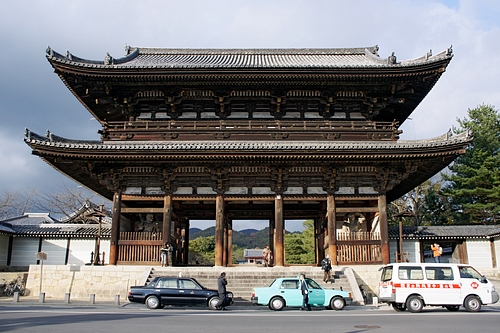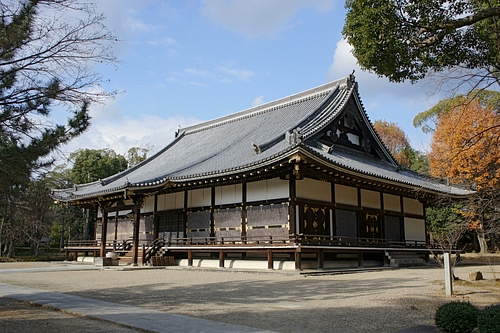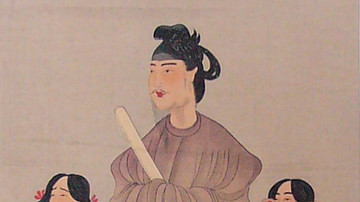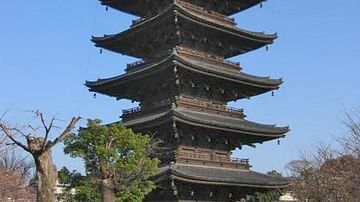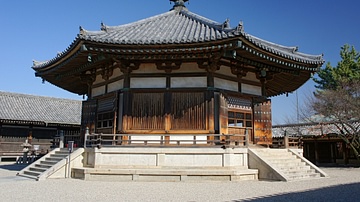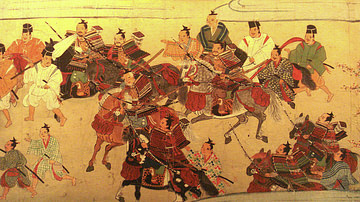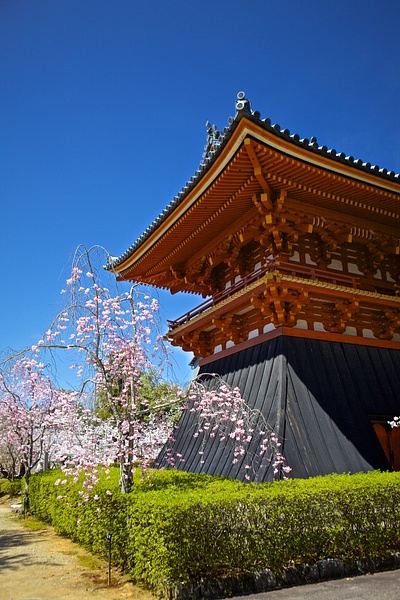
Ninnia-ji is a Shingon Buddhist temple complex located in Kyoto, Japan. Known as the 'Temple of Heavenly Benevolence', it was founded in 888 CE by Emperor Uda (r. 887-897 CE). Ninna-ji is listed by UNESCO as a World Heritage Site and its Main Hall is recognised as an official National Treasure of Japan. The site is today perhaps most famous for its Buddhist artworks and the large grove of cherry trees which provide a magnificent sight during their annual blossoming.
Foundation
Emperor Uda reigned in the final quarter of the 9th century CE, and he oversaw the completion of the construction of a Buddhist temple site in the western foothills outside the capital Kyoto (Heiankyo) in 888 CE. The name Ninna-ji derives from ninna ('Virtue and Harmony'), the posthumous era name of the reign of Uda's father and predecessor, Emperor Koko (r. 884-887 CE). When Emperor Uda retired from office in 897 CE he promptly took up the position of abbot, the temple's first. The royal connection to the site continued until 1869 CE with an imperial prince always being appointed as abbot.
The Omuro Palace
A suitable residence for such a prestigious post as the abbot of Ninna-ji was created, the Omuro Palace. Typical of a Japanese aristocratic villa, the various buildings of the palace, each connected by corridors and covered walkways, are laid out within a large walled garden. Also in the garden is a pond with the small stone bridge and distinctive boulders typical of Japanese landscape gardens; a traditional tea house used in the Japanese tea ceremony, the Hiro-tei Teahouse; and a pagoda. The Omuro Palace was unfortunately destroyed in a fire in 1887 CE, a fate often suffered by Japan's ancient wooden buildings. Reconstructed in 1915 CE, it today functions as a gallery of works by contemporary Japanese artists. The palace's main entrance, although nowadays only used during important ceremonies, is the Imperial Messenger's Gate or Chokushimon, which has a distinctive thatched roof. Access to the palace area for modern visitors is via the massive two-storey Sanmon Gate which is protected by a pair of large figures of Nio guardians. The gate, rebuilt in the 1630s CE, is one of the largest surviving examples in Japan.
Other Features
The main entrance to the Ninna-ji complex is via the Niomon Gate. Although the gate was destroyed during the Onin War (1467-1477 CE), it was later rebuilt. The original pagoda of the temple suffered a similar sad fate but was rebuilt in 1637 CE. Known as a Gojunoto pagoda for its five stories, it is notable that all its roofs are of equal size, a feature typical of 17th-century CE temple architecture. With its tall single metal spire or filial, the pagoda looms over the other, much lower buildings of the complex. The pagoda is listed as an official Important Cultural Property of Japan.
The temple's Main Hall or Kondo was once part of the royal palace of Kyoto where it functioned as a ceremonial hall but was moved to the site in 1676 CE and today houses an impressive golden Amida triad sculpture. The Kondo is listed as an official National Treasure of Japan and is typical of the architecture of the Azuchi-Momoyama Period (1568-1600 CE) with such features as large out-swinging windows, which are hinged at the top. The roof today is tiled but the original would have had cypress-bark shingles instead.
The Founder's Hall or Miedo is dedicated to the founder of Shingon Buddhism, Kukai (aka Kobo Daishi, 774-835 CE) and was also once a royal building. Next to the Founder's Hall is a two-storey bell tower. There is, too, a small guardian shrine, the Kusho Myojin Jinja, which is marked off by a wooden torii gate.
The complex includes the Reihokan Museum, which boasts many fine Buddhist artworks and artefacts (but is only open in the spring and autumn seasons). Amongst the most famous works hosted at the site is a celebrated painting of Prince Shotoku (574-622 CE), one of the great promoters of Buddhism in Japan. The prince is depicted aged just 16 and, wearing the splendid scarlet and gold robes of a priest, is caught in the act of offering incense to Buddha so that his father the emperor might recover from an illness. The painting is on silk and likely dates to the Kamakura period (1185-1333 CE) based on stylistic grounds even if it has been traditionally attributed to the 9th-century CE painter Kanaoka.
The second great artwork of the temple is the Amida triad which likely dates to the late 9th or 10th century CE. These sculptures of a seated Amida Buddha flanked on either side by a bodhisattva (Kannon and Seishi) are made from a wooden core which has been lacquered and then gilded. The impressive golden mandorlas or haloes behind each figure are a later addition. Amida stands 90 cm tall (35 inches) and the Bodhisattvas are larger at around 120 cm (47 inches).
The grounds include a grove of some 200 cherry trees, the blossoms of which attract thousands of visitors each spring. The blossoming is unique because of the lateness in the season - the last such spectacle in Kyoto's many temple sites - and because the trees are relatively short resulting in the blossoms hanging down to foot level. The hill behind the complex has a miniaturised version of the famous Kukai/Shikoku pilgrimage route with its 88 temple stops. This short version, known as the Omuro Pilgrimage, still takes two hours to complete. Finally, Ninna-ji is today host to the famous Omuro school of Ikebana or traditional Japanese flower arranging. In 1994 CE, Ninna-ji was added to UNESCO's list of World Heritage Sites as part of the 17 monuments of Kyoto group.
This content was made possible with generous support from the Great Britain Sasakawa Foundation.
